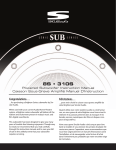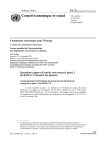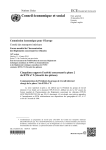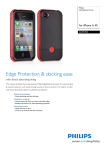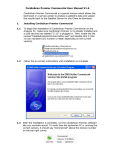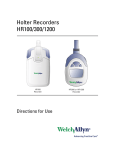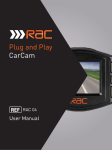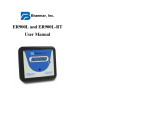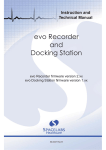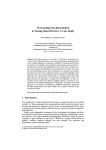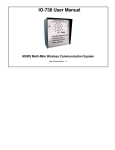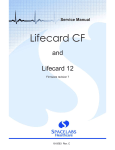Download BMS 300 Digital Holter Recorder User Manual
Transcript
BMS 300 Digital Holter Recorder User Manual MFG-LB-252.000 Table of Contents .............................................................................................................. Notices3 Manual Conventions3 Manufacturer’s Responsibility3 User Responsibility3 Equipment Identification 3 Copyright and Trademark Notices3 Important Information3 .......................................................................................... User Safety Information4 Intended Use4 Explanation of Symbols4 Warnings4 Cautions5 Notes5 ........................................................................................................ Introduction6 User Manual Purpose6 System Description6 .................................................................................................... Getting Started7 Secure Digital Card7 Battery7 Screen Navigation8 Selecting Features & Preferences 8 Set ID9 Set Name9 Pacemaker9 Sample Rate9 Record Length9 Real Time Clock10 .................................................................................. Attaching Recorder to Patient10 Patient Cable10 Patient Preparation10 Patient Hook-up10 ................................................................................................. Recording the ECG11 Data File Check12 Data Retrieval12 Recorder Messages12 ............................................................................................... Device Maintenance13 Inspection & Cleaning13 Testing13 Battery Maintenance & Precautions13 ........................................................................................... BMS 300 Specifications14 Notices Manual Conventions Warning statements describe conditions or actions that can result in personal injury or loss of life. Caution statements describe conditions or actions that can result in damage to the equipment or loss of data. Note: Notes contain additional information for usage. Manufacturer’s Responsibility Biomedical Systems considers itself responsible for effects on safety and performance only if: • Readjustments, modifications or repairs to the Biomedical Systems Holter recorders are carried out only by Biomedical Systems-authorized personnel. AND • The warranty is only valid if you use Biomedical Systems -approved replacement parts and accessories. User Responsibility The user of this product is responsible for ensuring the implementation of a satisfactory maintenance schedule. Failure to do so may cause undue failure and possible health hazards. Equipment Identification Biomedical Systems equipment is identified by a serial number on the back of the device. Please take care not to deface these numbers. Copyright & Trademark Notices This document contains information that is protected by copyright. All rights are reserved. No part of this document may be photocopied, reproduced or translated to another language without prior written consent of Biomedical Systems. Important Information Biomedical Systems reserves the right to change or amend this manual at anytime without notice. Biomedical Systems makes no warranty of any kind with regard to this material, including, but not limited to, the implied warranties of merchantability and fitness for a particular purpose. Biomedical Systems shall not be liable for errors or omissions that may appear in this document. Biomedical Systems makes no commitment to update or to keep current the information contained in this document. Before using the Biomedical Systems BMS 300 Holter recorder read this manual in its entirety and become thoroughly familiar with the contents. MFG-LB-252.000 3 User Safety Information Intended Use READ MANUAL FIRST The BMS 300 Holter recorder is a small, portable, digital Holter recorder intended for use by medical professionals to acquire ECG data from a single patient in a clinical,KEEP point AWAY of care FROM or outpatient setting. MOISTURE ECG data is first recorded to a Secure Digital (SD) card and then transferred to a Holter analysis system for review by a physician or other qualified professional. TYPE BF DEVICE Explanation of Symbols READ MANUAL FIRST Read Manual First DCCurrent CURRENT DC KEEP FROM MOISTURE Keep AwayAWAY from Moisture ELECTRONIC EQUIPMENT Electro nic Equipment DISPOSE OF PROPERLY Dispos e of Porpoerly TYPE BF DEVICE Type BF Device Manufacturer/ MANUFACTURER / MANUFACTURE YEAR Manufacture Year Warnings • • This device captures and presents data reflecting a patient’s physiological condition that when reviewed by a trained medical professional can be useful in determining a diagnosis. However,ELECTRONIC the data shouldEQUIPMENT not be used as sole means for determining a patient’s diagnosis. DISPOSE OF PROPERLY Use of accessories other than those recommended by Biomedical Systems may compro mise product performance. MANUFACTURER / MANUFACTURE YEAR To maintain designed operator and patient safety, any peripheral equipment and acces sories that can come in direct patient contact must be in compliance with IEC 601-1 and IEC 601-2-47. • Hardware is designed to meet or exceed IEC 601-1-2, however some environmental electrical interference may cause an artifact in the ECG. The quality of ECG signals may be adversely af fected by electromagnetic interference from environmental sources resulting in non-physiolog ical waveforms with the potential for misinterpretation. • This device is not intended for use during an MRI. • Before performing defibrillation or applying any high frequency surgical equipment to a pa tient, remove BMS 300 leads and electrodes from the chest area. Cable leads or electrodes trapped under defibrillator pads or paddles during defibrillation or electrodes in contact with high frequency electrosurgical equipment can cause patient burns. • Once one or more BMS 300 patient leads are connected to a patient, do not allow patient leads to meet with any grounded or live parts. Contact could cause unacceptable levels of electrical current to flow to the patient. • 4 DC CURRENT Cautions • Federal law restricts this device for sale to or on the order of a physician. • Carefully read all instructions prior to use. Observe all warnings and precautions noted in these diirections. Failure to do so may result in patient complications. • To prevent possible damage to the keypad, do not use sharp or hard objects to depress keys. • Although the plastic enclosure is designed for a clinical environment and can resist mois ture, neither the device nor patient cables should be cleaned by submersing into a liquid, autoclaving or steam cleaning. Wipe the exterior surfaces with a cloth dampened with warm water and mild detergent solution and then dry with a clean soft cloth. • No serviceable parts are inside. Only qualified service personnel may remove screws on the enclosure. The warranty is void if anyone other than qualified service personnel tam pers with the device. • Do not pull or stretch patient cables, as this could result in mechanical and/or electrical failures. Store patient cables after use by forming them into a loose loop. • Align patient cable connector and BMS 300 socket before plugging in patient cable. Forcing misaligned connectors can damage connector pins. • Avoid shock or sudden impact. Note: Excessive patient movement could interfere with the operation of the device. Note: Proper patient preparation is important to successful application of ECG electrodes and operation of the device. MFG-LB-252.000 5 Introduction This manual is written for clinical professionals. It is assumed that the reader has a working knowledge of medical terminology and procedures as required for monitoring cardiac patients. User Manual Purpose The User Manual describes how to safely operate the BMS 300 Holter recorder. In the manual, the following are described: • Preparing the device for use • Understanding and using the keyboard, screen and menu sequence • Acquiring and storing ECG • Maintenance System Description The BMS 300 Holter recorder is a portable, battery-operated Holter recorder used by trained technicians to collect ECG data from patients in a clinical, point-of-care or outpatient setting. Data is recorded to a Secure Digital (SD) card and then transferred to a Holter system for review by a physician or other qualified professional. 6 Getting Started A Secure Digital (SD) card and a battery must be installed to operate the BMS 300. The SD card must be installed before the battery is installed. Secure Digital (SD) Card The BMS 300 stores acquired ECG data to a standard SD card with capacity between 128mb and 2GB. Industrial style SD cards are suggested. To insert the SD card, remove the battery cover on the back of the recorder and insert the card face up as shown in Fig 2.1. Push it into the slot until it clicks into place. To remove the SD card, push the card into the slot and it will release. You can then pull the card out of the slot. The battery must be removed prior to inserting or removing the SD card. Battery The BMS 300 uses one alkaline AA battery (IEC-LR6). No other batteries may be used. To install the battery, remove the battery door on the back of the device, and place as shown on the placement reference molded on the inside of the battery compartment. If a battery has power, but is too weak to run a 24-hour study, the recorder will beep continuously and display a low battery warning. The BMS 300 monitors battery voltages during a study. It will run until the charge falls below an acceptable level. When this occurs the BMS 300 will shut down. Note: A loss of up to 2 minutes of data may occur if the battery is removed during a recording. Note: If the BMS 300 will not be in use for a prolonged period of time, remove the battery from the device. Cautions: • Insert battery as directed in this manual. Improper installation could damanage the device and impace the device’s ability to perform the patient’s ECG test. • The batteries used in this device may present a fire or chemical burn hazard if mistreated. Do not disassemble, heat above 100° C (212° F) or incinerate. • Keep the battery compartment dry. Do not immerse in water. Dispose of all batteries properly. Do not dispose in trash. Keep away from children. MFG-LB-252.000 7 Screen Navigation The BMS 300 use various menus to set preferences and enter patient information. Four keys, left, right, up and down, are used to navigate the menus. The enter key is used to make a selection of a highlighted item. Selecting Features & Preferences Start-up Upon insertion of a battery, the BMS 300 performs a system check and briefly displays the splash screen. The device serial number and firmware version are shown on the splash screen. The next screen to appear is the Setup Menu. Recording parameters and preferences are selected with the Setup menu. Press the Right Arrow key to exit the Setup menu and proceed with a recording. Note: Unless modified, Sample Rate, Recording Length, Date Format and Time Format will default to the previous session’s settings. Upon leaving the Setup Menu, the BMS 300 will prepare the SD card for recording and then enter the ECG display screen. The ECG display screen can be used to evaluate the patient hook-up. Pressing the enter key will cycle the ECG display between three channels of ECG and each of the three channels of ECG individually. The recorder will enter recording mode automatically in approximately eight minutes. Press and hold the enter key for four seconds to immediately enter record mode from the ECG display screen. Set-up Menu The Setup menu is used to set device preferences, time, date and enter patient information if desired. The following items can be selected on the setup menu: Set ID Set Name Pacemaker Sample Rate Record Length Set Time Set Date Preferences 8 Set ID Set ID is selected to enter a Patient Identification number. The navigation keys are used to navigate the character screen. Once a character is highlighted it can be selected with the enter key. After patient ID is entered, select DONE and press enter to return to Setup menu. Set Name Set Name is used to enter a patient name. The navigation keys are used to navigate the character screen. Once a character is highlighted it can be selected with the enter key. After patient name is entered, select DONE and press enter to return to Setup menu. Pacemaker The BMS 300 is designed to detect pulses generated by pacemakers. The recorder will detect signals from .1 ms to 2 ms that have rise times faster than or equal to 100 microseconds and amplitudes between +-2 mV and +-500 mV. Pacemaker annotations are made if the signal is detected on at least two channels. The pacemaker setting allows pacemaker detection to be set to either on or off. The default is off. Note: Patient lead placement and preparation are important factors to maximize accuracy of pace pulse detection. Noise with the above characteristics may be detected as pace pulse occurrences. Sample Rate Use the listings under sample rate to select desired ECG sampling rate. Sample rates of 128, 256, 512 and 1024 samples per second (sps) can be selected. Choose only sample rates supported by your particular Holter playback system. Sample rate defaults to previous recording session’s sample rate. Note: Sample rate choice may affect maximum recording length. Record Length Record length is used to select desired recording time. The choices are 24, 48, 72 and 96 Hrs. Sample rate, battery life and SD card size may affect maximum recording length. If a selected recording length is too long for the SD card size and selected sample rate the BMS 300 will display a warning message. Estimated Maximum Run Time in Hours. SD card size Sample rate 128 sps MFG-LB-252.000 128MB 256MB 512MB 1GB 69 72 96 96 256 sps 34 69 72 72 512 sps 17 34 48 48 1024 sps 8 17 24 24 9 Real Time Clock The time is set from the Set Time menu. The time can be displayed in either 12-hour or 24-hour format. The time display preference is selected from the preferences menu. The current time flashes on the display screen approximately every four seconds during recording. The date is set from the Set Date menu. The date can be displayed in MM/DD/YY or DD/MM/YY format. The display format is selected from the preferences menu. Attaching Recorder to Patient Patient Cable The Patient cable connects to a port on the left side of the BMS 300. The cable can only be inserted in one direction, and will easily snap into place when properly positioned. Do not force a cable into position. Both a 5-lead 3-Channel patient cable (part # 850-05R1-100) and a 7-lead 3-channel patient cable (part # 850-07R1-100) are available. Patient Preparation 1. Prepare the electrode site by removing oils and lotion from the skin. If necessary, shave the area where electrodes will be placed. Clean the skin at the placement site with an alcohol prep pad. Dry the area with a lint-free cloth. Use Silver Chloride disposable electrodes designed for 24 hour Holter monitoring. Do not use 12-lead ECG or Stress Test Electrodes. 2. 3. 4. Note: Proper patient preparation and electrode placement are important for acquiring a high quality ECG. Patient Hook-up In order to obtain a high-quality ECG signal it is necessary to maintain good electrical contact between the electrodes, patient cables and the patient’s skin. Suggested electrode placements are shown in the diagrams below in Figures 2.5 and 2.6. However, it is up to the physician to make the final placement determination. The recorder’s ECG display screen can be used to verify a proper patient hookup. Warning; • 10 Do not rely on the OLED display as a diagnostic tool. 5 Lead, 3 Channel Electrode Placement 7 Lead, 3 Channel Electrode Placemnet Read and follow instructions included with the electrodes. 1. 2. 3. 4. Check the patient cable for damage or wear. Replace if necessary. Use Silver Chloride disposable electrodes designed for 24 hour Holter monitoring. Place the electrodes onto the ECG leads. Remove the backing from the pre-gelled disposable electrode. Firmly place an electrode on each of the prepared skin surface sites. Dispose of any electrode that does not properly adhere to the skin. Recording an ECG Data File Check Once the battery is inserted, you will hear a “beep”, and the Splash screen will appear. The Splash screen displays the revision of the firmware for the recorder. Depending on the type of version of recorder, a screen may appear indicating the DATA FILE HAS NOT BEEN READ. This is a warning indicating the previously recorded ECG data file has not been played back in a Holter system. Either remove the SD card and download the file into the Holter system or press the enter key to continue to the Setup screen. The Setup screen is the next screen displayed. Follow the instructions in Section 2 to modify settings or press the right arrow key to proceed to the ECG display screen. Note: Unless modified, Sample Rate, Recording Length, Date Format and Time Format settings will default to the previous session’s settings. MFG-LB-252.000 11 The ECG display screen can be used to evaluate the patient hook-up. Pressing the enter key will cycle the ECG display between three channels of ECG and each of the three channels of ECG individually. The recorder will enter recording mode automatically in approximately eight minutes. Press and hold the enter key for four seconds to immediately enter record mode from the ECG display screen. During record mode the current time will flash on the screen every 3-4 seconds. Note: All keys on the recorder will operate as a patient event key during recording. Before the patient leaves the office inform the patient about: 1. 2. 3. The use of the event button and patient diary. Keeping the recorder away from moisture. Not removing the SD card or battery(s). Warning: • Removing and replacing the battery during a study may result in the loss of all patient data. Data Retrieval ECG data is stored on a SD card located in the battery compartment. To remove the SD card, push the card into the slot and it will release. You can then pull the card out of the slot. The ECG Data may now be placed into a card reader and loaded into the Holter software for analysis. Please refer to operating instructions for your Holter system. Warning; • ECG reports must be read by a physician who is trained to interpret an ecg study. Physicians should order a repeat study when the ECG is of poor quality. Recorder Messages Message Low Battery Possible Cause Low battery or rechargeable batttery Action Replace battery SD card not inserted SD card not fully inserted/ Bad SD card Insert SD card fully into recirder/ If fully inserted, replace SD card Press enter to ignore and continue or lead data into Holter system Data file has not been read SD card error Warning: Patient cable has not been detected Error: SD card is too slow for selected sample rate Warning: SD capacity is too small for sample rate and record length 12 MFG-LB-252.000 Previous data file has not been reviewed in Holter system/ Holter system did not flag data file as read Bad SD card or non-compatible SD Card Patient cable not inserted Low performance or SD card in deteriorating condition Chosen sample rate and record length exceed SD card size. Replace card Insert patient cable Replace SD card. Industrial style suggested. Insert larger SD card or reduce either sample rate or record time. Device Maintenance Inspection & Cleaning Routine inspection will help maintain the safety and performance of your BMS 300 Holter recorder. Before operating the device perform a visual inspection to identify any worn, broken or missing parts, and repair or replace as necessary. The outside surfaces can be cleaned with a mild soap and water solution. Do not dispose of unit in trash. Dispose of as the Waste Electrical and Electronic Equipment (WEEE) regulations for your area require. Cautions: • Do not immerse the device in liquid! • Do not clean the patient cables with alcohol. Do not autoclave them or use ultrasonic cleaners. • Do not use any harsh chemicals such as acetone, chlorine bleach, ammonia, or iodine to clean the BMS 300. Testing The BMS 300 executes a power-on self check when the battery is inserted. Any errors in the unit’s subsystems will be reported with an appropriate error message. Following the instructions on the screen and then removing and replacing the battery(s) can remedy most errors. A blank display indicates a discharged battery or a malfunctioning device. If error messages persist contact your Biomedical Systems service representative. Except for battery and SD card replacement, there are no user serviceable parts in the BMS 300. The unit must be returned to Biomedical Systems for service. The BMS 300 may also be tested by attaching the patient leads to a commercially available ECG simulator and verifying each lead has amplitude and morphology as described in the simulators manual. Excessive artifact usually indicates the patient cable needs replacing. Use only replacement cables purchased from Biomedical Systems. Battery Maintenance & Precautions Use only AA Alkaline Batteries (IEC-LR6). Use of another battery may present a risk of short recordings, device damage, or malfunction. Remove batteries from BMS 300 unit promptly when depleted. Never store a battery in the recorder. Cautions: • Keep the battery compartment dry. Do not immerse in water. Dispose of all batteries properly. Do not dispose in trash. Keep away from children. MFG-LB-252.000 13 BMS 300 Specifications Functional Specifications Channels of ECG:3 Patient Cable: 5 lead or 7 lead Download Interface: Secure Digital Card Reader or USB Cable Recording Duration: 24 hours to 96 hours (depending on SD card capacity) ECG Sampling Rates: 128, 256, 512, 1024 Samples per second Resolution: 10 Bit, +/- 5.0 mV Input Range Analog Bandwidth: 0.5 - 40 Hz, -3 dB CMRR:60 dB Pace Pulse Detection: Three channel detection - meets EC38 guidelines Physical Specifications Weight: Dimensions: Display: Batteries: Digital Storage Media: Resolution: Outer Case Coating: 4 oz. (114 gm) 3.45” x 2.6” (88 mm x 66 mm) OLED (Organic Light-Emitting Diode) One AA battery provides up to 96 hours recording Secure Digital Memory Card 10 Bit, +/- 5.0 mV Input Range Santoprene for durability and enhanced protection Environmental Specifications Operating Temperature: Storage Temperature: Non-operation Shock: Recorder Compatibility Compatible with the Century Series of Holter Analysis Systems (Versions 2.11 or later), and with Data Exchange Version 2.0. Biomedical Systems 77 Progress Parkway St. Louis, MO 63043 P: 1-800-877-6334 F: 1-314-576-1664 E: [email protected] www.biomedsys.com 0 to 60 degrees C -25 to 70 degrees C 26 inch drop















